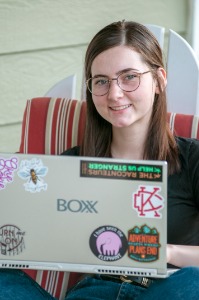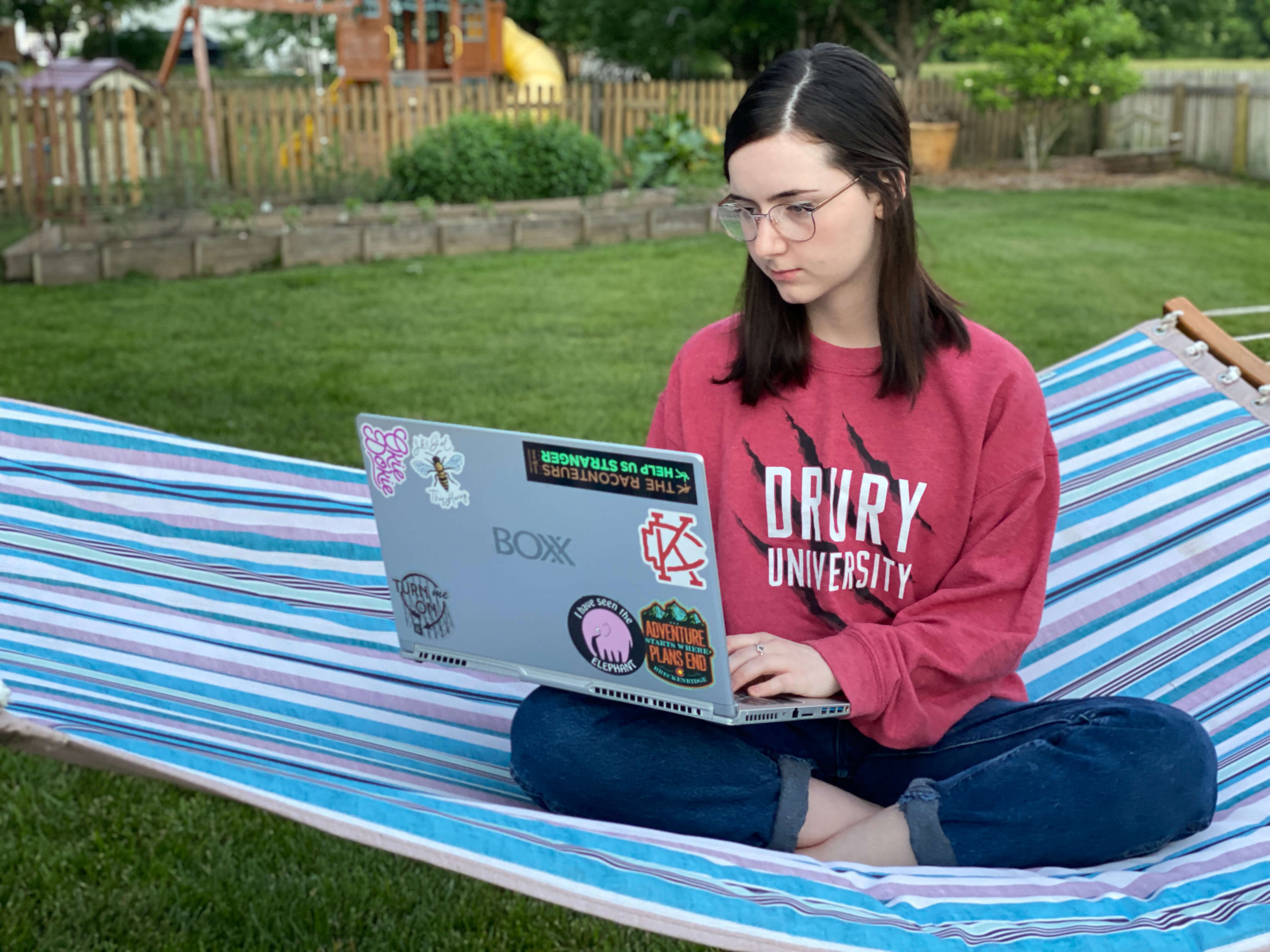When Olivia Smith needed a purpose-built laptop to run Autodesk Revit and Unreal Engine Twinmotion, she did what any sensible college student does—she called her dad. But not for the reason you think.
As those popular “My daughter and my money go to (insert your favorite university here)” bumpers stickers attest, when college kids call home, it usually involves hitting up mom and dad for cash. Nothing new to see there. In Drury University student Olivia Smith’s case however, one particular call was because she needed the expertise of her professional photographer father, a tech-minded parent who has built his own computer systems.
After repeated reminders from architecture professors to upgrade to a computer more suited to architectural applications, Smith put her father, Troy, on the search. “I’m not a technology person at all,” she admits. “I'm more into music, art, and that side of things, so honestly, it was kind of overwhelming looking at all the computer requirements.”
What soon became clear to both father and daughter was that even replacing her old MacBook with a new model would not provide enough power to support the workload. Worse yet, in many instances, the architectural software applications weren’t compatible with Mac at all. Being an on-the-go student, a desktop system was not an option either. “I definitely needed something I could take to and from the studio or library and still use as a laptop for my other classes,” she says.
Having just completed her third year at Drury, Smith, an Independence, Missouri native, had initially considered attending one of neighboring Kansas’ two major universities—both with stellar architecture programs. However, relatives in Springfield, MO convinced her to give Drury a look. “I toured it a couple of times,” she recalls. “I loved it so much the first time, I had to have the rest of my family visit too. Drury was the perfect size and everyone was really great, so I said, ‘This is it.”
Did she always dream of being an architect? Not really.
“I didn't know what I wanted to do,” Smith says. “I went into it a little bit blindly and when you’re a high school senior, there’s that pressure of ‘What do you want to do? ‘What direction are you moving in?’ I had taken some high school photography and art classes just for fun, but I also enjoyed the sciences and math. I didn't want to cut art or design completely out of my career path, so searching online, architecture seemed to be the career that fit. It combined everything I was looking for.”
As an architecture student, Smith has completed different types of projects. Her work entails primarily commercial buildings, as well as a recent residential project. The fall semester was highlighted by a Chicago fireboat firehouse, while this semester included a mixed-use residential building. Thus far, these have been individual, hypothetical projects, but next semester, Smith will go onsite and work with a team, as well as the community. “The community studies project is where you're actually working in tandem with the community on a funded project and they have an opportunity to follow through and implement that project,” she says.

When Olivia Smith is assigned a project, she first puts pencil to paper. “The quickest way for me to get my thoughts down in some sort of tangible manner is to sketch them,” she says. “I'll spend quite a bit of time sketching, drawing, and then, after a few process models and maybe some floor plans or sections, I’ll move it into the computer. Usually, I'm using Revit in the beginning because it’s very easy to bring stuff in and see where it goes. I'll do that to learn what I'm working with spatially.”
From there, Smith does some quick renders in Revit to in order to get a sense of the design (particularly materials). Next, she moves to Unreal Engine Twinmotion for more photorealistic renders. Introduced to the application by one of her professors, Smith is already a fan. “It’s a great asset,” she says. “Twinmotion it's so customizable, it's easy to go a little bit crazy with how much detail you can put into the model.”
Unfortunately, having the ability to add more refinements and create more iterations isn’t necessarily a blessing for a student pressed for time. “I'm always working, she laughs. “I don't know if that's because I have terrible time management skills or because I just put too much work into one thing. I don't know when to stop and I'm a night owl, so I don't quit until I'm at a solid stopping point. I’ll keep adding detail into models, which, when working on school computers, would increase the render time. I would be sitting in the lab for hours overnight. It was insanity.”
Incredibly long render times were certainly enough to spark Smith’s quest for a new computer, but the ideal system didn’t materialize overnight. She and her father found multiple laptops that could do this, that, or the other, but her father insisted that it had to be one that stood the test of time. “We don't want it to be something we're replacing two or three years down the road,” she remembers him saying. “He wanted to make sure that the requirements were above and beyond what I needed—not just enough to get by.”
After a long search, Troy Smith was convinced he had struck gold. "I research things sometimes more than I should,” he admits. “But during my research for a powerful computer capable of running architectural software, I kept reading about a company that I had never heard of—BOXX.”
“He said ‘Take a look at this GoBOXX. It's not a laptop per se. It's more of a workstation in a laptop,” his daughter recalls. “I'd never heard of BOXX before, but my dad laid out the specs, as well as the fact that there would be constant text support if I ever needed it.” Her father also wisely mentioned the amount of time she’d be able to save, or as he presented it, the amount of time she’d be able to sleep. She was sold.

Processors | Intel Core i7 (2.6GHZ w/ max Turbo frequency of 4.3GHz)
Memory | 32GB
GPU | NVIDIA Quadro P2000
Storage | 512GB SSD M.2 and 2TB storage drive
Display | 15.6 Full HD (1920x1080)
Once Smith began using the GoBOXX SLM, she still tried to move back and forth between it and her MacBook. Her entire life, she had been exclusively an Apple user, so transitioning to a new operating system took a little bit of time. “I'm not going to lie,” she admits, “it was difficult at first.”
Smith eventually severed ties when she realized she was only using the MacBook for Google searches. “I’ve adjusted well,” she says, “and it’s been a good change. I’ve been able to save so much time—just maybe not in sleep because I use the extra time to get even more work done.”
Smith had never rendered on another laptop before, just the Dell desktop PCs in the university lab. “My GoBOXX is just so much faster,” she says, “with little to no lag when rendering large files. I know I wasn’t doing anything like that on my Mac, but it was only a few years old and was already starting to glitch when I was running civil engineering programs. Honestly, the increase in speed and functionality was really significant right out of the gate versus the Mac or a Dell desktop. Everything runs smoother.”
Regarding the Dell workstations, Smith is adamant about the superiority of her laptop. “If I had to try and get my design work done on one of those PCs, I would have given up and gone home because it's difficult to click a button and have it render for five hours. I couldn’t do anything else because I didn't want to mess up the render. If I do the same render on the lab computers and on my GoBOXX, the Dell PC is over five hours and GoBOXX is done in an hour. It's just been amazing. GoBOXX is so much faster—and I can work from home.”
As for deadlines, Smith says there have been times, when some of her classmates and she are working right up to lunch because they are facing an afternoon desk critique with one of their professors, requiring a one-minute rendered clip of their projects.
“We all hit render on our computers and go to lunch,” says Smith. “We come back and mine is done, while their projects are still rendering—maybe only halfway finished. They know they will have to push their critiques back to the end of class, but unfortunately, mine gets moved up closer!”
Her classmates and professors have never seen a laptop quite like a GoBOXX SLM. “They had no idea what a BOXX was,” she laughs. “But whenever we're all working together doing the same process and you hear the sound of their computers like rockets taking off while mine is silent, they ask, ‘What's going on with that?’ I think students and professors have definitely been impressed with what it's been able to accomplish.”

Looking beyond college, Smith is eyeing a career in commercial architecture. “I like the large scale look of the projects,” she says, “but I also want to try and bring a personalized touch that makes it an interesting experience for each person—something on the inside that people can relate to.”
Our conversation turns to the importance of purpose-built hardware and technical support, as well as some of our more famous BOXXers like electronic musician and DJ deadMau5. I ask Smith if once she’s conquered the architectural world, will she still be using BOXX?
“I definitely will be,” she says. “I've been so impressed with the capabilities of the system and now knowing who else uses BOXX, it’s so cool, knowing that I have a support system regarding my technology. I'll probably upgrade someday to a desktop workstation, but I think BOXX will always be a part of my architecture career.”
Smith wraps up our conversation by saying how grateful she is for her father’s help and that the criteria he chose in helping her find the right laptop is the same one he has employed throughout her life—from art supplies to musical instruments, and more. “My dad always says when you can work with the best you, you do, because it makes your life so much easier. That's been very true with my BOXX experience.”
For Troy Smith, the credit goes to his own dad’s wisdom. "Growing up, my father had many jobs; police officer, sign painter, heavy machine operator, musician—and he excelled in all of them,” Troy recalls. “He always told me that the right equipment was a must. People can see it, hear it, and it makes your job easier.”
So…college kids don’t always call home for money. Sometimes, “kids” of all ages call for the best reason there is—expert fatherly advice.